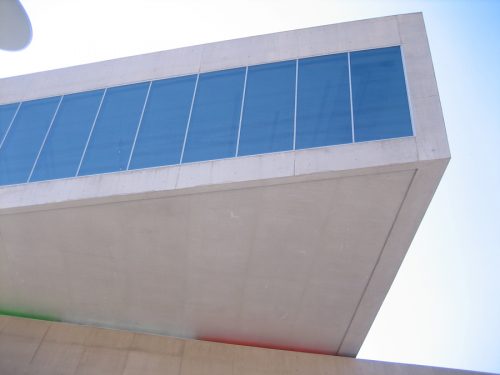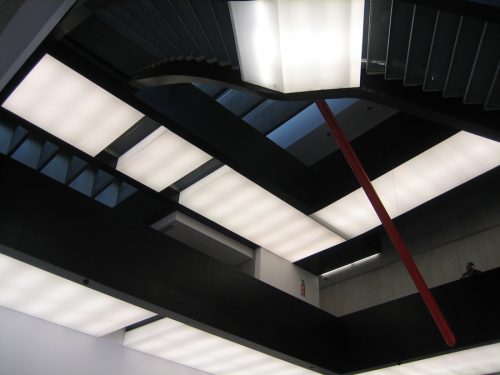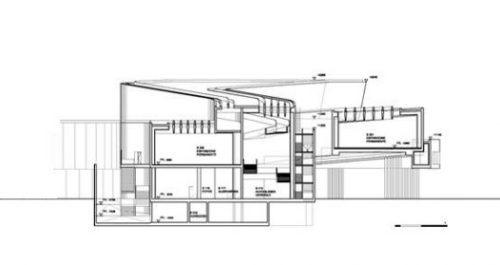Maxxi National Museum of Xxi Century Arts Rome Italy

Introduction
The MAXXI Museum in Rome by Zaha Hadid, has received the Stirling Prize for 2010, an award given to a building built or designed in Britain or a building synthetic in just the rest of Europe past architects whose headquarters is in the United kingdom.
In 1998 the architect won the international competition to build the new museum dedicated to contemporary art and architecture with an innovative project that fit the urban context, a project whose architectural resolution consists of a concrete construction with a drinking glass roof.
The National Museum of XXI Century Arts, MAXXI, belonged to the Ministry for Cultural Heritage Italian, later became founding, and had to follow a long process to completion, constantly threatened with budget cuts, survived four different ministers of Culture parties and various political and economic crises. "Information technology was tough, but worth it", summed Hadid, the mean solar day of his inauguration.
Status
This new museum stands on land originally occupied past an motorcar factory and later on past the army barracks and only in 2003 was granted by the Ministry of Defense to build the museum. At Via Guido Reni # iv, Rome, Italian republic, shut to the Olympic Village and the Music Palace in Rome architect Renzo Pianoforte
Concept
The thought of an "urban campus" is made with a blend of traditional building whose concept is overwhelmed by the interior spaces are expanded to include the entire city…. "I conceived the MAXXI as an urban campus, organized according to directional drift, flow, strength fields and density distribution, rather than by fundamental points," explained Hadid.
The complexity of the forms, and their sinuous contour variation of the dimensions and overlap joint determine a complex spatial and functional structure. Large walls are the most representative of this new edifice are curved walls that can exist used to exist exposed in the interior, but besides abroad, with murals, projections or installations. All versa around an indoor-outdoor existence. The concept of this project is based on the idea of "h2o" large urban areas with linear display surfaces, weaving a dense texture of interior and exterior spaces.
Description
Exterior

Despite the grandeur of its structure, distributed in 29,000 foursquare meters of land of which 21,000 are for exhibition space, and its sinuous forms the building not merely integrates harmoniously into the environment, but gives vitality to the whole neighborhood, afterward a century of military use. In their open gardens lies the Cosmic Calamita Gino de Dominicis, 24-meter human skeleton with Pinocchio nose.
Externally impacting the large rectangular torso that protrudes from the horizontal structure and smoothen concrete surfaces without windows that make their outer walls together with the flooring, the same fabric, over which laissez passer holes big every bit 45 meters broad or 20bmetros huge overhang outwards near the primary entrance.
Interior

Once within the fabric of surprising and gateways interlinked ramps at different heights and oft suspended in vacuum connecting rooms with corrugated walls, which are folded on themselves with openings both outside and within. Although patently a pharaonic piece of work, its design has been designed following ecological and sustainable criteria. The spaces, fluid and flexible thanks to a system of movable panels, enjoy natural light, calibrated past a sophisticated machinery, according to the seasons and the weather. The silky physical lining all the walls combined with glass and steel, giving the necessary neutrality spaces that works are the existent stars.
Equally it has in some of his works Hadid uses static elements to create energy and fluidity by manifestly randomly placed volumes in a given space. The National Fine art Museum this architectural resource was used in the entrance atrium, cafeteria, bookshop or stall tickets seem randomly located in the huge reception hall, with stairs or corridors that depart in unlike directions indicating that in that location is more to detect.
Spaces
With four floors of the MAXXI is full moving through undulating walls and stairs that seem to start or end anywhere, placing the visitor in a futuristic, floating offering multiple possible routes go all the museum allowing bypassing the aforementioned way.
Ground floor
A high-ascent spacious lobby provides access to the various exhibition halls, the auditorium, the room bibliomediateca and architecture files. In this hall the visitor has a cloakroom, a café and an information and ticket sales. In its structure include two museums, the MAXXI Fine art and MAXXI Architecture.

cut
Plant 1st-second-3rd
These plants are fully dedicated to showrooms. All plants have adjusted toilets.
A key feature of the projection is the apply of the walls equally spatial elements. The interiors of the galleries, nigh linear, are bounded by parallel walls that follow the longitudinal movement of the building, at other times past moving panels
In the words of Zaha Hadid: "One of the interesting aspects of the museum Rome, is that it is non but an object, but a plan to which you can add items. It is not only a museum merely a center. We designed weaving a dumbo texture of interior and exterior spaces, resulting in a provocative mix of temporary and permanent galleries, together with commercial galleries, irrigating urban plane in which surfaces are linear for samples. You can make connections between architecture and art and bridges connecting the van and transform it into a unified sample ".
Exterior, a pedestrian walkway, surrounds and penetrates buildings under the cantilevered volumes, restoring connectivity between the streets, which was interrupted for almost a century with the previously existing military construction at the site and was demolished to make style the museum
Structure
The blueprint of Zaha Hadid presents a structural challenge, a structure similar to the galleries, elongated linear spaces with concrete walls and floors made in situ with partially glazed roof that make something of channels with lids glass. Alan Jones, a structural engineer who was involved in the projection said that structurally, the edifice serves as the gateway of a building… "only the floors and walls proportional structural stability, not the ceiling…"
The construction likewise included large gaps had to be filled with reinforced steel confined with density higher than 300kg/m3. By reducing the number of joints was necessary to increase the physical poured over 70 meters high by 9, a complete plant, which required 260m3 of concrete in situ. The formwork was fabricated in Germany, modular panels of 9 meters long and 2.4 high which were assembled at the site and were linked using lasers to ensure the flat surfaces in the the discharge fourth dimension. Dumping in these areas a liquid mixture consisted of self-compacting concrete, a fine aggregate of limestone powder and an condiment in epoxy resin, which was immune to settle uniformly past the forcefulness of gravity and which was bandage around the reinforcement bars.
While the concrete is poured, the formwork panels are controlled to bank check the protuberances nanometers. Finally, as the pouring of concrete has to dry out slowly and evenly, without adventure of overheating, had to take into account the outside temperature did not exceed 25 °, in the Mediterranean climate of Rome these conditions can result only from November to Apr.
Statement seismic zone
In 2003, Rome was officially classified as seismic zone, which required that the structure of the museum was completely revised and reformed in some cases. Several sets of hydraulic pistons associated with the motion of the joints should exist incorporated into the concrete walls and floors and discarded movement joints 5mm 3mm other less visible, among other measures.
Materials
In its imposing structure include concrete, steel and glass. The physical covers non only walls and floors, but also was used in performing functional and decorative elements such every bit the lobby desk made of concrete and fiberglass. The concrete is the dominant chemical element in the design of Zaha Hadid.
The concrete walls were treated with a end "fairface" quality first, to improve their soft, without air bubbles, like the holes resulting from the screws or exposed joints of the spill, rustic to the lowest degree possible, according to sense of taste builder.
Plasterboard continued with concrete walls create cavities containing complex mechanical systems and museum technicians.
Roof

The arrangement used on the roof is a peculiarly complex, both technologically and mechanically. Is formed by an outer glazing, complicated systems with different types of shading blinds and bogus lite organisation, a temperature command system and guides moisture and resistant to hang heavy panels. The air conditioner is in the gap created between the upper skin of the double glazing and lower the glass ceiling.
The vertical blades which characterize the ceiling system are made of steel and coated with a finishing textile. The drinking glass is protected externally with a steel mesh that filters the light and piece of cake maintenance. All vertical columns, including columns that back up the overhang are steel.
Video
Source: https://en.wikiarquitectura.com/building/maxxi-national-museum-of-xxi-century-arts-in-rome/
Postar um comentário for "Maxxi National Museum of Xxi Century Arts Rome Italy"